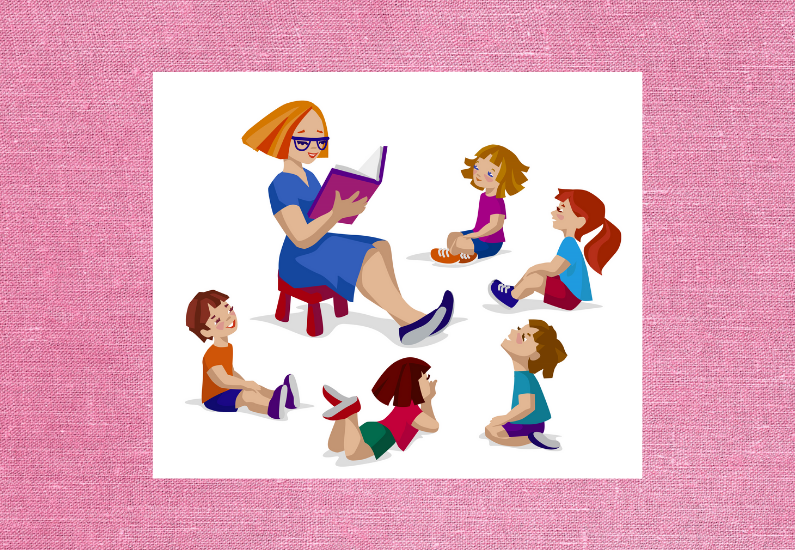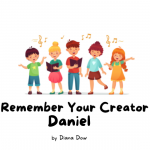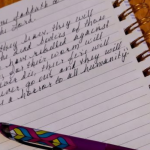There sure are a lot of great ideas available these days to help make teaching a Bible class easier and more fun. Just take a look around this website and you’ll see what I’ve come up with. Look at my Bible class board on Pinterest and you’ll see what other people are doing. Modern technology has made creating your own visuals and handwork a piece of cake. Timelines, maps, flip charts, attendance charts, 3-d panoramas, flannel graphs, bulletin boards, take home activities, work sheets are common in most Bible classes. I use some of these regularly and all of them at one time or another.
Sometimes, we get to thinking that we must have these things to teach children about God. They can’t learn about the wonderful stories God revealed to us if we don’t have a picture to show them or a hands on activity for them to do. Parents expect it. Grandparents expect it. The kids expect it. I’ve even heard of people choosing to worship with a particular group of people because of the well-equipped classrooms and impressive take homes used in Bible class.
It is a wonder that children learned anything back when copy machines, computers and the internet were not the norm. How did the children learn? Stories! Stories about people that obeyed God. Stories about people that disobeyed God. Stories about people that depended on God during hard times. Stories about the beginning of the world. Stories about Jesus and His life. Stories that were revealed to us in the Bible. God did not give us a picture book full of realistic visuals. He gave us a book that had the story of His great plan in vivid detail, in symbolic parables, in brief statements that carried great messages.
But that’s not all. He didn’t just leave us with a book. He told us how to teach our children using this book. Deut. 6:7,
“You shall teach them diligently to your children, and shall talk of them when you sit in your house, when you walk by the way, when you lie down, and when you rise up.”
There was no need for a timeline and a map. All that was required was a teacher, a student and the word of God.
How can we teach if we don’t have pictures to show and activities to do? We need to read the previous verse, Deut 6:6 to find out how these parents of old were able to teach their children as they were going about their daily life.
“And these words which I command you today shall be in your heart.”
The word of God must be in the teacher’s heart. That means the teacher must know what the lesson is about. The teacher must have studied it to the point that it is part of him/her. Not a quick run-through on the way to church that morning but consistent diligent study.
A well prepared teacher will be able to open the Bible and read the lesson in such a way that the children in the class will be able to visualize the events in their own minds.
- The teacher will read from the Bible, not a Bible picture book.
- She will impress on her students the importance of going straight to the word of God.
- She will take into account the age of her students, paraphrasing parts that are difficult to understand.
- She will be a good storyteller.
Jesus was a good storyteller. He met the student where they were at and taught them the way they would understand. No fancy visuals, just speaking from the heart the things He wanted the people to know.
Am I giving up on using visual aids and activities in my Bible class? No way. What I am doing is depending more on the word of God to teach the children. My students have learned that we aren’t going to play a game every week or have a visual every week. We use these things but, like seasoning food, we use them sparingly.
Here’s a challenge. I took this challenge for the first time several years ago. It changed my way of thinking about teaching my Bible class. The next class you teach, take only your Bible. Read the lesson from your Bible. Use voice inflection, simple gestures and enthusiasm to draw your students into the story itself. See the reaction of your students. The first time I did this was with a preschool class. I was amazed at how the children were listening so intently. I would love to hear your experience with this challenge.








Diana,
I found your blog through a pin I saw on pinterest. As I began reading through it, I saw your family photo and realized you are Andrew’s and Timothy’s mother! My sister, Jeni, and I met them last year at singing school. They were fun to hang out with and I was impressed with their ability and eagerness to be active in worship service, considering how young they are.
I appreciate that you share your wisdom and knowledge of teaching the Bible to young children. If you have time I have a question or two for you about teaching Bible class. I usually take the younger class in our congregation, k-2nd (which has one consistent student). Recently, I have had a few students attend who are not familiar with going to Bible class or worship service. I have struggled with trying to explain to them basic Biblical concepts, such as: Who is God? Why do we worship him? Why do we come to Bible class? What does He look like? Why can’t we see Him?
This article has been helpful. I think I can look for answers to these questions in the scriptures and paraphrase to make the language more kid-friendly and on their developmental level. But if you have any thoughts, ideas about how to explain these concepts to children who don’t learn them at home, I would be grateful!
Thanks!
Stephani Blair
Hi Stephanie, I asked Timothy about you and he said he remembers you well. It sounds like you have a great opportunity to introduce God to these precious children. I’m sure you’re doing an excellent job. As they hear the great stories God chose to share with us they will begin to discover the answers to those questions on their own. “Who is God?” and “Why can’t we see Him?” are questions that challenge mature Christians as well. They will discover who God is as they learn about the wonders He has done for those that love Him. Just keep teaching them and praying for them and loving them. Sometimes, I think we try to give kids all the answers. We need to teach them what the Bible says and let them discover how wonderful God is.
Thank you, Diana. :)
I will keep these thoughts in mind as I prepare my lessons.
Diana, I’m so glad you have posted this.
Yes, our Bible study should be most enjoyable, but, never forget it is hard work to learn and students gradually need to understand that it is their own effort to learn that will bring them benefit and joy, not the extras that the teacher provides.
Thank you for this! I’ve been trying more to read the story out of the Bible, but my Bible class doesn’t seem to pay very much attention to it. I don’t know if it’s how I’m doing it or if they’re just not used to sitting and just listening. Do you have any suggestions on how to do this when the kids are 2, 3, 6 and 11? Thanks!
Marla
That’s a good question, Marla. The first time I did this, I read straight from the Bible. I think it was about Noah so it was a story they were familiar with. I think the kids were so mesmerized because it was so different than anything they had ever heard in Bible class before.
The 6 and 11 year old should be able to sit and listen to a longer lesson but with a 2 and 3 year old in there, you’ve got a challenge on your hands.
Keep the story telling short. The stories we have written down for us that Jesus told were not long at all. As the children get accustomed to listening and you get accustomed to telling/reading the lesson, they will stay focused for longer periods of time.
Draw the students in to the lesson by calling them by name. “James, Noah built the ark just like God told him to.” Or something similar. I do that when I see a child shutting down or zoning out. It brings them back to where we are.
Ask questions or ask them to summarize the story after you’re done. If they know ahead of time that there is going to be something expected of them, they will listen more.
Make the story part of the whole. Start with a review to bring everyone up to the lesson. Then, continue but reading/telling the story from the Bible. Doing this continually, every week, will give them the idea that this is one story, not a bunch of disjointed ones.
Leave a cliff hanger if possible. Tell them, “We’ll find out what happened next, next time.”
Hope these ideas help. Keep up the good work.
Love this! Yes, I usually just open my bible and tell the story. I do usually use flannel graph pieces as a visual aid and I put the pieces on the board as I come to them in the lesson. But I am a big fan of just opening the bible and telling the lesson. You are right. They listen so intently!